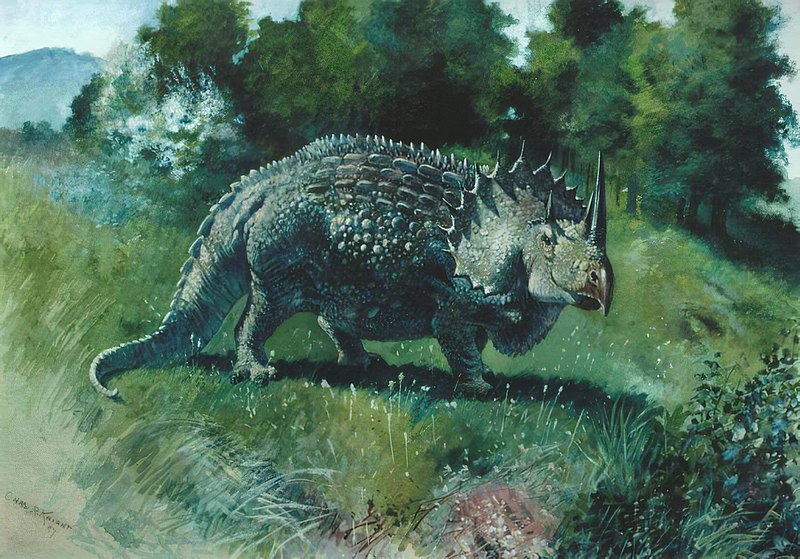[Recent Entries][Archive][Friends][User Info]
| February 18th, 2015 | |
|---|---|
| 06:23 pm [industrialterro] [Link] |
Agathaumas Агатаум (от Agataumas — «огромное изумление») — сомнительный род динозавров семейства Цератопсиды, живших 70—65 млн лет назад (середина кампанского — конец маастрихского яруса позднего мелового периода) на территории нынешней Северной Америки. Достигал в длину 9 метров, высоты 3 метра и веса 5 тонн. Окаменелости агатаума были найдены в округе Суитуотер (Sweetwater County) штата Вайоминг. Впервые описан палеонтологом Коупом в 1874 году. Представлен одним видом — Agathaumas sylvestris. Останки агатаума обнаружил американский учёный Ф. Меек в 1873 году при раскопках в штате Вайоминг (США). Он сообщил об этом известному палеонтологу Эдварду Коупу, который немедленно прибыл на место и занялся изучением находки. Название своё — «огромное изумление» — агатаум получил потому, что учёные были сильно потрясены размерами животного. В 1897 году художник Чарльз Найт по заказу Э. Коупа сделал ряд рисунков ящера, которые в 1925 году послужили Уиллису О’Брайну основой для создания образа агатаума в фильме «Затерянный мир». Agathaumas (/æɡəˈθɔːməs/; "great wonder") is a dubious genus of a large ceratopsid dinosaur that lived in Wyoming during the Late Cretaceous (late Maastrichtian stage, 66 million years ago). The name comes from Greek, αγαν - 'much' and θαυμα - 'wonder'. It is estimated to have been 9 metres (30 ft) long and weighed 6 tonnes (5.9 long tons; 6.6 short tons), and was the largest land animal known at the time of its discovery. It was the first ceratopsian known to science, though relatively little is known about it. The original specimen consisted only of the animal's hip bones, hip vertebrae and ribs, and because these bones vary little between ceratopsid species, it is usually considered a nomen dubium. It is provisionally considered a synonym of Triceratops, but is difficult to compare to that genus because it is only known from post-cranial remains. The fossil remains of Agathaumas were first found in 1872 in southwestern Wyoming. They were discovered by Fielding Bradford Meek and H.M. Bannister while they were looking for fossil shells in the Lance Formation (then Laramie Formation) near the Black Butte and Bitter Creek. Meek and Bannister were employed by Ferdinand Hayden's Geological Survey of the Territories, and notified paleontologist Edward Drinker Cope of the find. Cope himself searched the ridge near Black Butte and re-discovered Meek's site, finding huge bones protruding from the rocks near a coal vein. The bones were preserved in sand and clay sediments, packed with fossil sticks and leaves, indicating a heavily forested habitat. Cope later (in 1873) described the skeleton as "the wreck of one of the princes among giants." Later in 1872, Cope published a description and name for the animal, Agathaumas sylvestris, or "marvelous forest-dweller," in reference to its great size and the environment revealed in the same rocks as its bones. The name Agathaumas has been cited as an example of Cope's excitement with this discovery, which was, at the time, the largest known land animal that had ever lived (until several years later, with the discovery of the giant sauropod dinosaurs of the Morrison Formation. Cope and his team eventually recovered complete hip bones, sacral vertebrae, and several ribs from the animal. Since these were the first ceratopsian remains found, Cope was uncertain as to precisely what sort of dinosaur Agathaumas was (and for a time considered it a hadrosaur) until O. C. Marsh described Triceratops in 1889. In an 1889 paper, Cope suggested that Marsh's Ceratopsidae be renamed Agathaumidae, because of the paucity of Ceratops remains. Unfortunately, the bones of the rear half of the animal found are not particularly diagnostic in ceratopsians and Agathaumas remains a nomen dubium. No other remains have been found in the area, but based on its size and age of the rocks, it probably was a Triceratops. Хасмозаврины или цератопсины (Chasmosaurinae или Ceratopsinae) — подсемейство птицетазовых динозавров, обитавших в позднем меловом периоде (около 77—65 миллионов лет назад). Все известные виды были четвероногими и обитали в основном в Северной Америке хотя один вид, Тураноцератопс, известен из отложений Азии. Большинство представителей этого подсемейства обладают лишь шишковатыми «зачаточными» рожками, расположенными над глазницами, в отличие от своих ранних предков), тогда как трицератопс наоборот имеет крупные костяные наросты. Самым ранним из всех известных рогатых динозавров в Северной Америке является зуницератопс (Zuniceratops), живший 90 млн лет назад.
Tags: Вымершие рептилии, Мел, авеметатарзалии, архозавроморфы, архозавры, диапсиды, динозавроморфы, динозавры, маргиноцефалии, неорнитискии, птицетазовые, хасмозаврины, цераподы, цератопсиды, цератопсы |

